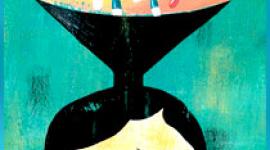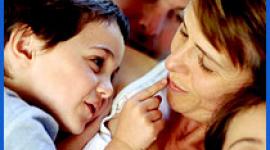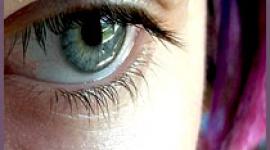Impact of Bipolar Disorder on Girls
How does bipolar disorder affects girls? Frank talk about premenstrual symptoms, self-injury, hypersexuality, addiction, weight gain, more in bipolar girls.
Girls with Bipolar Disorder: Special Concerns
 What remedy is there for the teenage girl with bipolar disorder who suffers suicidal depression for several days before each menstrual period? How do bipolar illness and its treatments affect a girl's sexual feelings, fertility, and unborn children? What can parents do to keep a risk-loving daughter safe as she passes through adolescence?
What remedy is there for the teenage girl with bipolar disorder who suffers suicidal depression for several days before each menstrual period? How do bipolar illness and its treatments affect a girl's sexual feelings, fertility, and unborn children? What can parents do to keep a risk-loving daughter safe as she passes through adolescence?
As parents, we dread our daughters' descent into the maelstrom of raging hormones, bipolar mood swings, adolescent rebellion, street drugs and alcohol, and medication side-effects. Families seeking professional guidance often feel trapped in a revolving door of disjointed referrals—to pediatricians, psychiatrists, psychotherapists, substance abuse counselors, gynecologists and endocrinologists—hearing from each some version of "sorry, that's not my area of expertise." Meanwhile, a girl's energy, judgment, demeanor and appearance can vary dramatically throughout the month depending on which biochemical, hormone, or neural circuit has seized the reins. Bonds forged or projects begun in periods of wellness or mania may be abandoned in despair or derailed by impulsive self-injury and suicide attempts, which themselves bring further trauma. Periods of extended grief and shame can occur when a girl comprehends the depth of her wounds.
Cognizant of the risks our growing daughters face in the world beyond our doors, and of that fast-approaching eighteenth birthday when our role as legal guardians abruptly (and absurdly) ends, we scramble to equip them—and ourselves—with the knowledge, tools and skills needed to survive the perils that lie ahead. Too often, lacking the means to protect our beloved daughters, we grieve—then rage—as did the Greek goddess Demeter upon learning that her young, risk-loving Persephone had been abducted to the underworld.
Note: Concerns discussed in this article may be painful to discuss or recall.
Risk factors and gender
In childhood, fewer girls are diagnosed with bipolar disorder than boys. CABF's 2003 Membership Survey revealed that 65% of its members' affected children are male and 35% female. Some neuropsychiatric illnesses—such as autism—affect girls at lower rates than boys, and others—such as schizophrenia—tend to emerge later, on average, in girls. Beginning in adolescence, bipolar disorder occurs with equal frequency in males and females. Girls, who often are less disruptive in school than boys, or whose symptoms are more internalized than externalized, may be less likely to be referred for treatment. There are as yet no epidemiological data from research studies to inform us how many prepubertal girls or boys, for that matter, actually have bipolar disorder.
In adults, women appear to manifest rapid-cycling and depression more often than men, but gender differences remain largely unexplored.
Menstrual irregularities
Parents of girls with bipolar disorder often report on the CABF message boards that their daughters have difficulty with their periods. Females with bipolar disorder may have higher than usual rates of anovulation (absence of periods) and longer than normal cycles. These abnormalities are associated with an increased risk for diabetes. Heavy bleeding and severe cramps interfere with school attendance and participation in sports. A consultation with a gynecologist and/or endocrinologist may be helpful if puberty seems abnormally early or delayed or if periods are highly irregular or painful. Careful charting of symptoms and monthly cycles is essential, and should be started at the earliest possible time. Several mood charts are available on the CABF Web site (see below).
Premenstrual symptoms
Some CABF parents report that their daughters have a sharp increase in irritability, depression, impaired concentration, sleeplessness, panic attacks, self-injury or anxiety prior to their first menstrual period, and experience these symptoms before each subsequent period. Symptoms of other chronic illnesses—epilepsy, migraine, and multiple sclerosis, for example—also are known to worsen premenstrually. A sudden increase in symptoms may signal that a period is imminent, but until the bleeding actually starts, it is impossible to tell whether the symptoms are worsening due to the hormonal change.
Psychiatrists in the emerging specialty of reproductive psychiatry study the interaction between mood and hormonal changes at all stages of a woman's life. They find that premenstrual dysphoric disorder (PMDD) (a severe form of premenstrual syndrome, or PMS) may be associated with a serotonin deficiency during the luteal phase (second half) of the monthly cycle. Low serotonin is associated with depression. The current treatment for simple PMDD includes low-dose antidepressants, such as a selective serotonin reuptake inhibitor (SSRI), administered for a few days during the luteal phase. However, girls with both bipolar disorder and PMDD who take SSRIs risk increased cycling, irritability, or induction of mania. Some CABF parents report that their daughters become disinhibited on SSRIs, with increased self-injurious and suicidal behaviors.
Other treatment strategies have been reported in medical journals and by parents on the CABF Web site, but data supporting these strategies in teens and young women with bipolar disorder are limited. For patients taking lithium, doctors may order pre-and-post period lithium levels to determine whether the level is dropping premenstrually. If so, and the girl's periods are regular and predictable, dose adjustments can be made as needed. Some doctors prescribe birth control pills or the contraceptive patch. One recent study of women with bipolar disorder found that women taking oral contraceptives had much less cycling during the entire month than women not receiving oral contraceptives. Some gynecologists will prescribe "the Pill" to be taken continuously for several months at a time. The Pill reduces the risk of unplanned pregnancy but some medications—such as Trileptal® and Carbamazapine—interfere with the effectiveness of oral contraceptives. Trials of several different brands (with differing types and levels of hormones) may be necessary, and some girls report increased depression on some brands. In some studies, complementary and alternative measures, including light therapy, exercise, L-tryptophan, calcium carbonate, and cognitive behavior therapy have been shown helpful in treating PMDD. Benzodiazapines are sometimes prescribed for premenstrual anxiety and agitation, but they can be abused and create dependence.
Self Injury
Self injurious behavior is the deliberate, repetitive, impulsive, non-lethal harming of one's body. With onset at puberty, girls may cut themselves with razors or household knives, or use any number of means to scratch, pierce, or otherwise injure the skin in a behavior that has become endemic in America, according to Wendy Lader, Ph.D., clinical director of the S.A.F.E. Alternatives Program at Linden Oaks Hospital near Chicago and coauthor of Bodily Harm: The Breakthrough Healing Program for Self-Injurers (Hyperion, 1998).
Signs that a girl may be cutting include telltale bandage wrappers or bloodied tissues in the bathroom wastebasket, broken-off razor heads from disposable razors on a bedside table or in a dresser drawer, or red lines and scabs on her belly, thighs, or the insides of her wrists. Sometimes girls wear sports wristbands to cover the scars. Girls may find it a self-soothing, but addictive behavior, often learned from movies, or other girls in schools and hospitals.
If a girl is found to be self-injuring, this does not necessarily mean she is attempting suicide, although girls who self-injure can also be suicidal. Self-injury is best treated by therapists using cognitive-behavioral therapy working with the girl's psychiatrist who prescribes medications. In severe cases, residential treatment or hospitalization may be needed.
Hypersexuality and rape
The overtly sexualized and impairing behavior of many children and adults with mania is called hypersexuality. This behavior is little understood by the public or professionals who work with children. Clinicians, social workers, and teachers may jump to a false conclusion that the child is being sexually abused, and horrified parents may find themselves the prime suspects. In a study led by Barbara Geller, M.D., among a group of young subjects in which the rate of sexual abuse was less than 1%, hypersexuality was displayed by 43% of the prepubertal children with bipolar disorder.
Girls who dress and act provocatively and lack mature judgment are likely to draw the attention of sexual predators. Rape is a very real threat for these girls, whose behavior (even when driven by a brain disorder) may be viewed by authorities as consent. A Florida court recently held that the rape of a 14-year-old girl with bipolar disorder by four older males did not violate its statutory rape law when the girl had sneaked out of her home for a rendezvous with her boyfriend. One mother showed me a picture of her lovely daughter, age 13, who accepted rides and food from "friends" (pimps) who drove her to Chicago and Detroit to engage in prostitution (the girl had symptoms of bipolar illness from an early age but had not yet been evaluated by a psychiatrist). The newsletter Preventable Tragedies, a publication of the Treatment Advocacy Center, recently reported the story of a 16-year-old girl with bipolar disorder who ran away from a youth center in New Jersey in July, 2004, and was found one month later on a street corner in the Bronx, covered with bruises and apparently forced into prostitution. An article on the web site of the Treatment Advocacy Center summarizes research documenting the increased risk of sexual assault to females with bipolar disorder and schizophrenia.
The Internet is also a potential source of harm. Girls may find accounts of their sexual histories posted online by former friends turned bullies. Some caregivers report finding nude photos of their daughters attached to sexually explicit e-mails between the girls and "boys" met online, along with plans to meet in person. Parents must stress the potential dangers of such behavior, and educate our daughters about the symptoms of hypomania or mania and the importance of making safe choices-not an easy task, given the late development of the frontal lobes of the brain (thought to be the seat of judgment). Early training in self defense, strong parental controls on Internet use (or removal of access altogether), and sex education are a must. Some parents send their vulnerable daughters to boarding schools or residential treatment centers hoping to prevent the consequences of impulsive sexual behavior such as rape, STDs, unplanned pregnancies, and stigma.
Treatment itself can affect sexual behavior. This topic is entirely unstudied in young patients with bipolar disorder. Antidepressants can fuel manic behavior, including hypersexuality; or, alternatively, dampen sexual desire. The use of Wellbutrin®, an antidepressant, to restore libido in adults with antidepressant-related sexual dysfunction, raises the question whether it might stimulate hypersexuality in girls with bipolar disorder. There is no research to guide us on this question. Prolactin is often found to be elevated in girls and boys taking atypical antipsychotics—elevated prolactin levels are associated with breast enlargement and lactation in both sexes (see below). There may be other understudied hormonal side effects of long-term treatment, such as "cellular memory," where a medication taken in childhood changes a patient's response to hormones years later. Longitudinal studies that follow children taking these drugs throughout development and into adulthood (alone and, as is more common, in combination with other medications) are desperately needed to answer these questions, but federally-funded and pharmaceutical industry-funded research rarely extends beyond the first few weeks or months.
Pregnancy
Hypersexuality and impulsivity often lead to early sexual behavior and pregnancies in teens with bipolar disorder. Girls need to know the facts about sex and understand the importance and means of preventing unplanned pregnancy. A young woman with bipolar disorder who finds herself pregnant while taking medication and who wishes to continue the pregnancy needs prompt medical attention to develop a treatment plan that provides stability while minimizing risks to the baby, before, during, and after delivery. Childbirth often triggers episodes in women with bipolar disorder, who are at high risk for post-partum psychosis and depression. Husseni Manji, M.D., chief of the Mood and Anxiety Disorders Section of the National Institute of Mental Health, says that postpartum psychosis is almost exclusive to females with bipolar disorder (and often undiagnosed until then). "It looks like it's not the magnitude of hormonal changes, but the impact of the "normal" hormonal changes that interacts with a specific neurobiological vulnerability," says Manji.
Babies exposed to psychiatric medications in the womb can suffer birth defects. A young woman who wishes to become pregnant needs to discuss this intent with her psychiatrist prior to conception, as medications may need to be changed or removed during certain months of the pregnancy to minimize risk to the child.
Substance abuse and addiction
The effects of substance abuse are magnified in females; a woman with bipolar disorder is approximately 7 times more likely to have a substance use diagnosis than is a woman without bipolar disorder (the comparable increased risk in men with bipolar disorder is three-fold). Early cigarette smoking appears to prime the brain to be more responsive to other drugs like cocaine, and females addicted to nicotine have a harder time quitting than do males. Teenagers become addicted faster than adults. Street drugs (such as marijuana, cocaine, and ecstasy) as well as nicotine can cause psychiatric symptoms. Smoking pot can cause psychosis and hostility, destroy a girl's motivation for learning and achievement, and render her incapable of concentrating or comprehending what she reads (these are also symptoms of schizophrenia, which typically emerges in the late teens and early twenties). An increase in these symptoms during the teenage years, or any level of known substance abuse, should be a red flag to parents, who may then choose to require mandatory random urine testing and outpatient drug treatment as a condition for living at home. Residential treatment centers with strong recovery programs may offer the best chance to treat the often considerable effects of street drugs on the bipolar adolescent, and research shows that earlier interventions make recovery more likely.
Hyperprolactinemia
Antipsychotic medications may increase the secretion of prolactin by the pituitary gland. Prolactin stimulates the production of breast milk (called galactorrhea when it occurs in non-nursing women and men), and hyperprolactinemia (high levels of prolactin) and may lead to estrogen deficiency and, in turn, bone loss, amenorrhea (absence of periods), and infertility. Prolactin also may elevate testosterone levels in females, leading to acne and/or excess body hair growth. Few of these questions have been studied in children or teenagers receiving these drugs, and it remains unknown what long-term implications there may be in teens who show elevated prolactin without any clinical signs. It is not yet known whether medications taken in childhood will affect future response to female hormones during puberty and adulthood.
Weight gain and acne
Bipolar disorder is associated with obesity, diabetes, and heart disease. Sadly, the side effect profiles of medications currently used to manage bipolar disorder also include significant weight gain and diabetes. Weight gain is likely to leave a girl unwilling to take the prescribed medication. Parents informed in advance of these possibilities can help prevent obesity and promote treatment compliance by providing their daughter with a program of frequent, vigorous exercise, and placing the whole family on a healthy diet free of junk foods and high-calorie sodas (fruit-flavored, no-calorie spritzers are available if your daughter wants something to drink from a can). Consultations with fitness trainers and nutritional experts can be helpful in getting started (and may be covered by insurance). Exercise helps depression by delivering more oxygen to the brain and raising serotonin, a brain chemical found to be abnormally low in people with depression, and is associated with numerous improvements in various measures of mood, cognition, and physical health. No research studies have yet been done to measure the effects of diet and exercise on weight control or cognition in adolescents with bipolar disorder. For some, the appetite is so stimulated by a medication that dieting is impossible.
Acne, a potential (but not inevitable) side effect of lithium, is also distressing to adolescents. Acne in a girl may be a sign of hormonal imbalance. If lithium is working to stabilize mood, dermatologists can usually treat acne with prescription skin care regimens. As with all medications, if side effects become unmanageable, a change of medication may be needed.
Polycystic Ovarian Syndrome
Parents of girls taking valproate (an anticonvulsant sold in the U.S. as Depakote) need to know that it may precipitate hormonal abnormalities and lead to excessive hair growth, ovarian cysts, decreased menstruation, elevated testosterone levels, and central (abdominal) obesity. These symptoms can lead to polycystic ovarian syndrome (PCOS), which in turn increases a woman's risk for infertility, diabetes, and cardiovascular disease. This concern surfaced in a 1993 study from Iceland, in which 20% of women on valproate over the age of 20 with epilepsy had PCOS, as did 60% of women in the study who began taking it in adolescence. "These data are compelling and warrant that families of children and adolescents be fully informed of these findings before valproate is begun, and that menses in girlsand testosterone levels in girls as well as boys are monitored during treatment," says Barbara Geller, M.D., who chairs CABF's Professional Advisory Council. "As PCOS can be associated with infertility, it is important that this potential side effect be discussed with families. Future studies can address the frequency of early PCOS symptoms in children with bipolar disorder who receive valproate." The causes of PCOS are probably many (including weight gain and epilepsy), and some girls may be genetically predisposed to the condition.
Studies of adolescent girls with bipolar disorder on valproate have not yet been conducted; however, a recent review by Dr. Hadine Joffe of Harvard found that adult women with bipolar disorder taking valproate had substantially more treatment-emergent symptoms of PCOS than women taking other medications (10.5% compared to 1.4% for non-users) and the difference in symptoms appeared within the first year of valproate use. "Based on our findings, it is important for doctors prescribing valproate to monitor women taking the drug for signs of PCOS," says Dr. Joffe.
Oral contraceptives with low-androgenic progestins and glucophage, an anti-diabetes medication sometimes used to control insulin resistance and weight gain, may have beneficial effects in girls with PCOS, but data are lacking in this age group.
Residential treatment
Some parents reluctantly conclude that residential treatment is necessary for their vulnerable daughters with bipolar disorder. Residential treatment centers with good clinical care allow girls with bipolar disorder to be educated in a safe, structured, recovery environment that provides therapy, psychiatric care, teaching of coping strategies for impulse control and management of overwhelming feelings, along with round-the-clock staff supervision. If substance use and unsafe sexual behavior is discovered, intervention by placement in a wilderness program for girls or a residential treatment center (typical stays are six to eighteen months) that offers a good substance abuse program may divert a girl from becoming trapped in a lifelong cycle of addiction, hospitalization, and relapse. Intervention is most likely to succeed when done in the early stages of substance abuse and addiction, although no research has been done on the prevention of substance abuse and addiction in children with bipolar disorder as they pass through the age of highest risk. Placement in a residential treatment center is often not covered by health insurance, quality of care varies tremendously, and fees range from $3,500-$7,000 per month (better facilities typically have higher fees). Educational consultants can help with finding a suitable placement, and school districts will sometimes cover the academic costs.
Conclusion
Girls with bipolar disorder face enormous risks. We, as parents and helping professionals and researchers, must educate ourselves about the risks associated with bipolar disorder in girls, including the consequences of lack of treatment and treatment side effects. We must seek or create environments-sometimes, of necessity, away from the home and community-where our girls can be educated, receive medical care and taught self-awareness and management of their symptoms and cycles, in order to help them seize the reins and navigate the territory ahead. We must insist upon vastly increased federal funding of research on all aspects of diagnosis, treatment, and prevention of pediatric bipolar disorder. We must teach our girls, those who survive their sojourn in the underworld, how to use the insight and wisdom they gained there to heal and illuminate the way for others. Like Demeter, we must raise our voices in grief and outrage at the prospect of losing our daughters forever.
About the author: Martha Hellander, J.D. is Child and Adolescent Bipolar Foundation Research Policy Director
next: Mood Swings and Drugs
~ bipolar disorder library
~ all bipolar disorder articles
APA Reference
Staff, H.
(2008, October 13). Impact of Bipolar Disorder on Girls, HealthyPlace. Retrieved
on 2025, April 25 from https://www.healthyplace.com/bipolar-disorder/articles/impact-of-bipolar-disorder-on-girls



